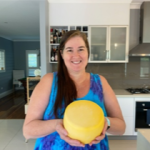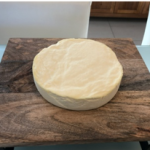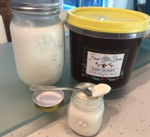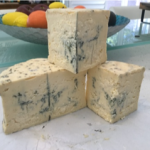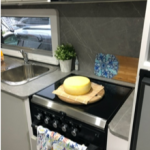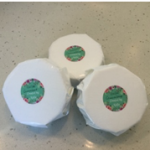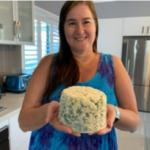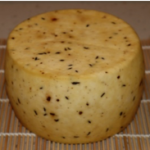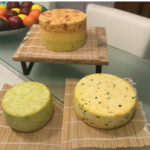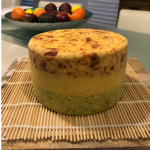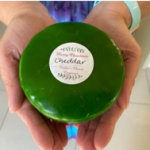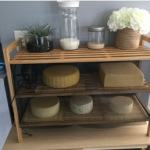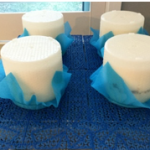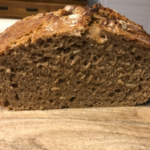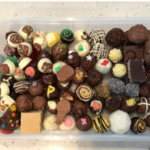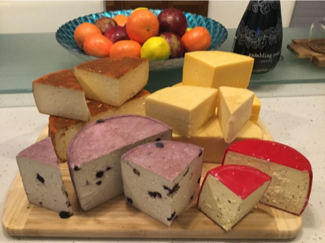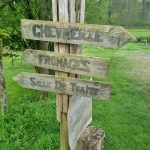When did you take up cheesemaking and why?
I’m a very new cheesemaker – my first batch of cheese was whipped up on April 21st this year. During Covid lockdown, my daughter and I were challenging each other to make things from scratch – of course, sourdough bread, butter, yoghurt, scones etc. that led to the inevitable making of a pizza from scratch – dough, sauce and basil from the garden were easy enough to make but I’d need to do the cheese to go on it. So, I bought myself a cheese kit. One for mozzarella and one for hard cheeses. And that was when the fun began.
What was the first batch of cheese you made by yourself? How did you feel about the experience and how did the cheese turn out? Can you compare your experience between then and now?
The first cheese I made was a Farmhouse Cheddar (I prefer the pressed cheeses for eating and my husband only eats Cheddar). I followed the recipe but as I do with everything it was ‘loosely’ followed and I had no idea how important temperatures etc. were. I also halved the recipe as I didn’t want to waste too much milk if it didn’t work out. The resulting pancake thin cheese took over a week to dry (I had no idea I needed to lift it up off the plate I had it on). The very next day it was time to tackle mozzarella. I followed the recipe pretty precisely (rare for me!) and it turned out really quite well! It did very well on our ‘from scratch’ pizzas. After the mozzarella went so well, I had high hopes for the cheddar (still drying on the bench). I eventually vac packed it and waited 1 month for it to mature. It had a nice texture but no taste! I realise now cheddars need much longer to mature. I still have a quarter of that cheese maturing in the cheese cave – I’m sure it would be much better by now! Feeling pretty confident after the successful mozzarella, I proceeded to make 2-3 cheeses a week. I was hooked and just had to try all the different types of cheeses. To date, I’ve made over 70 batches of cheese, with very few repeats of the same recipe. I love exploring new techniques or flavour combinations.
There is something very therapeutic in setting a curd, cutting it, stirring it etc. It’s a rewarding way to spend a day!
What sort of cheeses (& dairy products eg yoghurt) do you make, how many times have you made cheese, why do you like making cheese and how often do you make it?
I’ve made yoghurt on and off for years now – homemade yoghurt is just the best! I’ve also started making cultured butter and love that too. Making cheeses has also introduced me to kefir, so now I have my grains on the go, I make kefir each day.
I try to have one ‘cheese day’ a week (though sometimes I’ll sneak in 2 or 3!). I’ve made most types of cheeses now, hard, soft, bloomy white, blues, washed rind (first one is due for cutting next week!) and fresh cheeses, with my favourites being the bloomy whites, blues and Goudas. I did a smoke flavoured Gouda that disappeared very quickly it was so delicious! I like experimenting with flavours, so tend to add things into my cheeses. I’ve also experimented with cultures and constantly buying more/different cultures and ripening cultures. Graham has a great range of these. I’m always mixing and matching to put together a taste that is hopefully unique. I tend to make cheeses I want to taste. Usually, these are cheeses you don’t see in the shops, like the Chocolate Cheese I have ageing at the moment (combining two of my favourites!). I also try to re-create what I have liked in store-bought cheeses, which is what lead me to do my Trilogy Cheddar. I cannot wait to taste that one in October!
What cheese do you regularly have in your fridge OR What cheese cannot you do without?
I always seem to have a Blue on the go, as most of my family keep requesting this one (Buttermilk Blue is most popular although I have a Stilton that is almost ready and looking delicious!). Also, my kids love Komijnekaas (Dutch heritage) so I have made a wheel of that each month and it always disappears before the next one is mature enough to eat.
What is your advice to anyone looking to starting out on a cheesemaking journey?
Jump in, have a go and start with what you like to eat, that will keep you motivated. People will tell you to start with simple fresh cheeses like ricotta but if you don’t like ricotta (I don’t particularly) you won’t be enthused by your results. Halloumi has more flavour, as does Feta if you want a simpler cheese to start with, but I started with pressed cheeses and don’t regret it for a minute. Read the recipes, get prepared and enjoy the experience. Also, be prepared to be patient while your cheese ages, it’s worth the wait.
Do you have a favourite cheesemaking recipe that you can share with others? (others do like to copy their recipes).
My cheesemaking recipes come from others. I haven’t come up with one of my own from scratch as yet. ‘ The Art of Natural Cheesemaking’ by David Asher has very simple, easy to follow recipes. And for creative flair, I like the recipes in ‘Artisan Cheesemaking at Home’ by Mary Karlin.
I did come up with the Trilogy Cheddar method. You are welcome to have a go at that using your favourite Cheddar recipe. You will need two extra followers for this method (extra followers are available at cheesemaking.com.au if you want to buy some, or you can cut them from plastic cutting boards to match your existing mould). Try to work quickly, and keep your curds warm so be prepared and have everything ready in advance.
Here is a quick rundown of what to do:
- Make your cheddar following your chosen recipe up to the point where you have milled the curds and mixed through the salt (right before you put the curds in the mould)
- Weigh the curds and split them into three equal parts into three sanitised bowls
- Add chopped sundried tomatoes to one bowl of curds (these were the dry tomatoes not packed in oil, boiled for 2 mins to get rid of any germs) and mix well
- Add chopped fresh basil to the next bowl of curds (I used fresh basil blanched in boiling water to kill any germs but you could also use dried herb) and mix well
- Add liquid smoke to the final bowl of curds (I used hickory smoke about ½ tsp) and mix well
- Take the basil flavoured curds and place them in your cloth lined mould – pack down lightly with your hands and then place a follower on top.
- Next, add the smoke flavoured curds and repeat the process of packing down lightly with your hands and then placing a follower on top.
- Next, add the tomato flavoured curds and pack down lightly with your hands. Fold the cloth over the top neatly and then place the follower on top.
- Your curds are now ready for the initial press – press lightly for 15 mins – then carefully remove from the mould. Unwrap and it’s time to remove the followers
- Carefully and gently – pick up the first tomato layer using the follower, flip it onto your hand so the follower is now on the top, remove the follower and then place the cheese onto a clean cloth. Repeat this process for the smoke flavour, remove the follower and this time place the cheese on top of the tomato layer on the clean cloth. Finally, place the basil layer on top.
- Wrap and return the cheese to the mould and press as usual (following your usual cheddar recipe – I left it 1 hour till I did the next flip)
- Air dry and age according to your cheddar recipe (I’m ageing mine 4 months if I can wait that long!)
- Enjoy!
Do you have a favourite cheese(s) and cheese pairing(s)?
Yes. Pair your favourite wine with your favourite cheese and you can’t go wrong! I make sourdough crackers that are excellent with soft cheeses, and also a roasted red pepper jam that goes fabulously with any cheese and cracker!
What cheese do you want to make but have not made?
Raclette. I have been putting it off mostly because I think it’s going to be stinky and I don’t know if I’ll like that strong flavour. I will make it though, it’s on the list! I have a list of cheeses to make that never ends as I seem to find new recipes all the time, or come up with some variation I want to try.
On Friday I’ll be making some mini goudas to give away at Christmas (pressing them in the Camembert hoops and waxing each in bright wax). My next experimental cheese I’ll be trying is making a Farmhouse Cheddar with Peppercorns turn blue. I’m going to introduce some penicillium roqueforti and see how it goes. Cheddar may be too hard for the blue to fully penetrate and have lots of veins, but hopefully, I’ll get a little bit of a blue flavour through it anyway.
Do you have any equipment you like to use?
I bought a sous vide which has helped keep temperatures steady. I love my collection of all different shapes and size moulds, it’s fun to pick one to match the cheese I’m making.
I also love my cheese drying rack I made from a shoe rack from Kmart and fly screen. It works super well and I often have a cheese or two on the go that is air drying.
Is there a favourite book or resource that you reference most to get technical information?
- I have used the culture chart from Cheesemaking.com.au so much! You have to convert most recipes to ‘Aussie available’ cultures and this chart is just wonderful for doing that. I love it.
- The handy hints that Graham has around his website, even little tips next to the moulds you buy are just excellent and make the cheese journey so much easier (for instance, I recently saw the tip to cut small blue squares of plastic cloth to fit the top of the camembert moulds, put a rubber band around to stop your curds falling out when you flip them. I love this, it works perfectly!!).
- ‘The Art of Natural Cheesemaking’ by David Asher
- ‘Artisan Cheesemaking at Home’ by Mary Karlin
Do you have food-related hobbies outside of cheese, we all like these sorts of foods so include references and images of them also. e.g. sausages, small goods, meats, wine, bread, jams, chutneys, cakes…?
I give everything a go. I routinely make my own sourdough bread and crackers and wraps. I make jams, marmalades and chutneys. Yoghurt, kefir and cultured butter, even homemade ice cream regularly happens in my kitchen. I’ve brewed kombucha and kimchi and sauerkraut. I even got into cake decorating (wedding cakes); there is nothing I haven’t tried baking. I love cooking and I’m very confident in the kitchen.
Since I was 16, I started making handmade chocolates at Christmas for my family as gifts. This has evolved over the past 44 years to now spending the month leading up to Christmas making thousands of handmade chocolate truffles. I have about 40-50 different flavours/recipes that are just phenomenal! There is nothing I can’t craft from sugar or chocolate.
When my cheesemaking took off, I told my husband I’d like to try making some cured meats (salami/sausages) to go with my cheeseboard but he has drawn the line “no bits of meat to be hanging around the house smelling of garlic”
Finally, whatever you think may add to your story.
I think cheesemaking is a wonderful hobby. It’s creative and productive at the same time. I had a wonderful day helping my daughter make halloumi (she’s 30 and it’s one of her favourite cheeses so we made it together). Cheese brings families together (well, they all come to the table when the cheese platter goes out!) and provides a canvas for creativity and personality to shine through. I’m new to cheesing, but I can’t see me getting sick of it any time soon, especially since I still have this long list of cheeses to make!
What has been some interesting or rewarding cheesemaking experience/s?
Most rewarding is my family and friends asking for more cheese. Even making about 4 different cheeses a week can’t meet the demand for more more more! Also, when I make a new cheese I have no idea what it will taste like (as I haven’t tasted that type of cheese in my life), I just like the sound of it, and it turns out awesome, like Ibores, Caerphilly and Butterkase. Just delicious!
I really enjoyed making a Trilogy Cheddar. I came up with the method myself just by working out what I wanted to achieve and making it happen. I took a basic cheddar recipe and when it was at the milled curd stage, split it into three equal parts. I mixed sundried tomatoes into one, fresh basil into another, and liquid smoke into the third. I then assembled it into the mould. First the basil layer, then add a follower (I cut two extra followers from cutting boards), then the smoke flavoured layer went in, add a follower then add the sundried tomato layer and top with the final follower and press. I kept the curds reasonably warm, removed the additional two followers after 15 mins and then pressed as usual. It came together perfectly and the layers worked out quite neatly! I’m hoping it tastes as good as it looks.
What has been your biggest cheesemaking challenge/s?
The most challenging thing about experimenting with flavours and cultures is having to wait 2-3 months (or more sometimes) to see if they worked! I keep a journal so I know what I did if I want to recreate it.
Also, timing what cheeses I make so that I have enough time to tend to them. Because I’ve made so many cheeses (I’ve now got 4 wine fridges on the go full of my little babies), some of them need more tending than others. I have to time when I make the ‘flip each day’ or washed rind ones for when I’m going to be home for a while, to work around taking holidays (we have a caravan and go away for a week regularly). I once made a Butterkase just before going away and it wasn’t dried yet, so it came on holiday in the van with me so I could flip it and make sure it dried ok (I took the vacuum sealer with me so I could tuck it away in the fridge once it was dry). I’ve even had to ask my Mum to cheese-sit a batch of Valencay that needed flipping when we were going away for a week.
At the moment I have a Jarlsberg, Swiss, Montasio, White Stilton, Blue Stilton, Port Salut, a batch of Triple Crème and a batch of Brie Nuit that I flip each day. I’ll be relieved when I can vac pack/wax/wrap some of these to tuck away for ageing. I’m also running out of room in my fridges as the cheeses to be flipped are still in maturation boxes. It will be good to get some more real estate for more different cheeses yet to be born!
Another challenge is controlling unwanted mould on cheeses that aren’t ready for ageing yet. It’s driving me nuts washing my Jarlsberg and Swiss all the time only to have the mould grow back. I’m going to end up with washed rind cheeses at this rate!
Trying raw milk was interesting. It was very hit and miss. I had a few fails and learnt the hard way that you have to reduce the culture and rennet in recipes or you’ll get bitter cheese! Also, if you are not tending your own animals, it’s hard to know 100% that the milk quality is good. I had one batch of contaminated milk that resulted in throwing the cheese out which was heartbreaking. I now either pasteurise my milk or buy store-bought pasteurised milk. It’s a lot more consistent in results.
I also find it challenging to make 3 different cheeses at the same time. I’ve done it a few times when I only have one day to get my cheesemaking fix. It’s hard to time them all to need stirring or draining at different times! I try to only do two at once when possible.
The other challenge I face is getting my husband to try anything that isn’t a cheddar 
What is your favourite cheese(s) to make?
Camembert. I love watching the white coat grow! Likewise with my blues. Fabulous to watch the evolution when you flip them each day. I made Brie Nuit (experimenting with adding a little DH40 to the cultures, compliments of Graham, thanks mate!) on the weekend and I’m looking forward to watching the white grow on the black ash surface. I’ve only experienced that once when I made Valencay.

